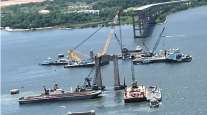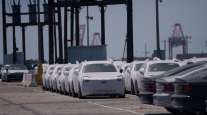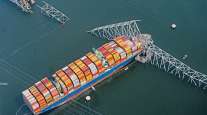The Detroit News
Automakers Face Workarounds Due to Port of Baltimore Closure
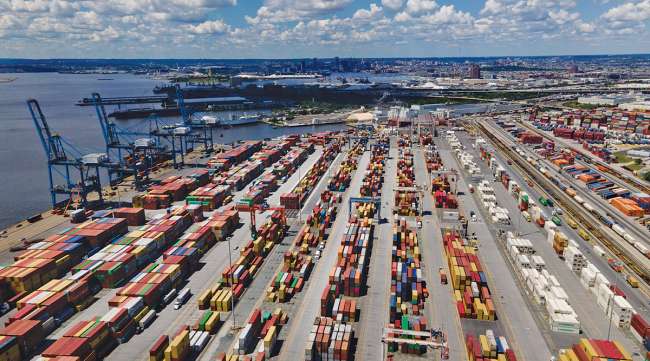
[Stay on top of transportation news: Get TTNews in your inbox.]
The Maryland bridge collapse that severed access to the Port of Baltimore early March 26 is expected to cause some shipping delays and logistical headaches for the auto industry.
The Baltimore port handled 847,158 cars and light trucks in 2023 — the 13th consecutive year it led all other U.S. ports in that sector. It’s unclear how long the port will be closed as investigators review what happened when a containership struck the Francis Scott Key Bridge at about 1:30 a.m., causing it to collapse into the Patapsco River below.
Detroit’s three major automakers rely on the Baltimore port to different extents and were assessing the effects March 26. Foreign automakers like Mitsubishi Motor Corp. said they were significantly affected, though at least two that lean heavily on Baltimore for importing — Volkswagen AG and BMW AG — have operations located just outside the zone cut off by the bridge debris.
The potential automotive shipping interruption comes after years of automakers and their suppliers battling supply chain woes following the pandemic, including the 2021 semiconductor shortage that resulted in millions of fewer vehicles being produced and hundreds of billions of dollars in lost revenues. The crisis pushed the industry — from automakers to dealers — to rethink the handling of the supply chain.
“It’s a large port with a lot of flow through it, so it’s going to have a lot of impact. It’s just at this point we’ll have to understand what that means for us specifically,” Ford Motor Co.’s Chief Financial Officer John Lawler said in an interview with Bloomberg television. “We’ll work on the workarounds. We’ll have to divert parts to other ports along the East Coast or elsewhere in the country. And it’ll probably lengthen the supply chain a bit.”
The Port of Baltimore said in a statement that all vessel traffic to and from the port was “suspended until further notice,” though trucks were still being processed at its marine terminals. The port said it didn’t know how long vessel traffic would be halted as authorities searched for several people missing and began cleaning up the wreckage of the bridge.
Maryland Gov. Wes Moore said during a media briefing he also did not have an estimate on how long it would take before shipping could resume because the early focus of response efforts was on saving lives after members of a construction crew had fallen in the water during the collapse. By midafternoon, authorities said they remained focused on search-and-rescue efforts.
Even with unknowns on a reopening timeline, the auto industry should be able to navigate the situation given the disruptions of the post-pandemic years.
“The number of times that the OEMs and suppliers have had to jump through hoops and have additional inventory in place and their contingency plans for their contingency plans, this is probably just somebody opening up a playbook that they developed over the last three years ... and just quickly pulling the levers,” said Dan Hearsch, Americas co-leader in the automotive and industrial practice at AlixPartners LLP, a financial advisory and global consulting firm.
Detroit News reporter Kalea Hall joined Kevin Dietz and Tom Jordan to discuss how vehicle trade will be disrupted byt he bridge collapse. https://t.co/aLaA8sSRYQ — WJR 760am (@wjrradio) March 27, 2024
“The visibility that companies have into where their products are in terms of being in a container on a particular ship is so much better today than it was four years ago that the uncertainty is probably not eliminated, but it is so much less than it used to be.”
Automakers React
General Motors Co. expects the situation will have “minimal impact to our operations,” said spokesperson Kevin Kelly, adding the automaker is “working to re-route any vehicle shipments to other ports.”
Stellantis NA, meanwhile, was “initiating discussions with our various transportation providers on contingency plans to ensure an uninterrupted flow of vehicles to our customers and will continue to carefully monitor this situation,” said a statement sent from spokesperson Jodi Tinson. The automaker would not say how many of its vehicles or parts came through Baltimore.
Nissan Motor Co. doesn’t expect “significant” impact from the bridge collapse and Kia Corp. does not expect any, though Mitsubishi said the Baltimore port is “one of the key inbound shipping locations” that it uses.
“It is too early to understand the impact this situation will have, but we are working with port staff to monitor activities, and we will adjust as needed to minimize any inconvenience to our customers and our dealer partners,” a statement sent from spokesperson Jeremy Barnes said.
Mercedes-Benz also said it was affected, as the Baltimore port, along with others such as New Brunswick and Charleston, are used by the automaker for vehicle imports. Spokesperson Anna McGregor said the company was watching the situation closely with its transport partners, and considering if it needed to tweak supply routes.
“We have several options available within our flexible supply chain network,” she said.
Toyota Motor Corp. spokesperson Curt McAllister said in a statement that Baltimore is not the primary port for Toyota’s North American operations, but “there will be some impact, primarily on vehicle exports. At this time, we do not anticipate a significant disruption, but we are evaluating the situation closely to determine the longer-term impact and countermeasures.”
Subaru Corp. expected no impact on its operation since the company does “not use that port for any ocean freight and the bridge is not a route taken for any direct shipment to our facility,” spokesperson Craig Koven said in a statement.
Both Volkswagen’s brands as well as BMW have major import operations in Maryland. But they are both based at a large private facility called Tradepoint Atlantic, closer to the mouth of the Patapsco River, in an area not affected by the bridge collapse.
“Since the terminal is located at the harbor entrance, in front of the bridge, it can still be accessed. We are in contact with our logistics partner,” BMW spokesperson Phil DiIanni said in a statement. The facility can process as many as 100,000 BMW vehicles annually.
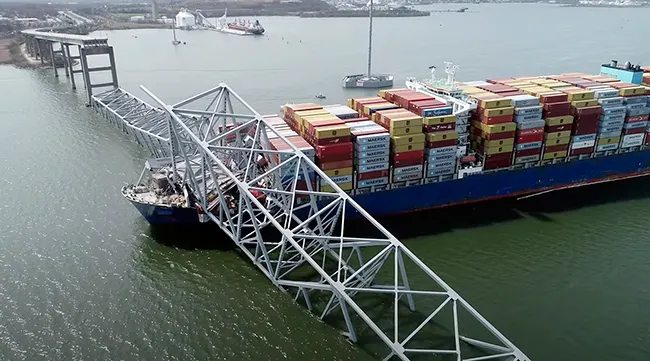
In this image taken from video released by the National Transportation and Safety Board, the cargo ship Dali is stuck under part of the structure of the Francis Scott Key Bridge after the ship hit the bridge March 26 in Baltimore. (NTSB via Associated Press)
Volkswagen spokesperson Mark Gillies said in a statement the company’s “port operations are not affected by this incident as our Baltimore facility is located on the seaboard of the bridge collapse,” adding VW in 2023 received, processed and shipped about 100,000 vehicles through Baltimore for dealers in the Northeast and Mid-Atlantic United States.
“We do not anticipate any impact on vessel operations, but there may be trucking delays as traffic will be rerouted in the area,” Gillies said. A Tradepoint Atlantic spokesperson confirmed its terminals weren’t expected to be hampered and would “resume normal operations once the immediate rescue and recovery activities” are complete.
Beyond autos, the Port of Baltimore also specializes in handling farm and construction machinery, sugar, gypsum and coal, while cruises also frequently depart from there. In all last year, the port’s public and private terminals handled 52.3 million tons of cargo worth $80 billion, officials reported.
Prepared for Interruptions
Since the COVID-19 supply chain interruptions that resulted in plant shutdowns week after week in 2021, automakers and their suppliers have adapted by ensuring they have clear lines of visibility into their supply chains. These measures of finding out where supplies come from and where they are at any given time are to avoid halting production and, consequentially, losing money.
“Time is money is definitely true,” AlixPartners’ Hearsch said. “We can’t afford in our industry, additional costs and loss that is just because we’re not paying attention.”
Drone footage from @NTSB showing the challenges that crews are facing in the recovery and clean up effort of the now collapsed Francis Scott Key Bridge in Baltimore. This was during clear conditions Tuesday. Today - Wednesday, it’s dark and rainy. pic.twitter.com/2M6vMpABSw — Adam Tuss (@AdamTuss) March 27, 2024
Hearsch equated the Baltimore port situation to what automakers dealt with when the Ambassador Bridge closed in 2022 because of a coronavirus restriction protest by Canadian truck drivers. It reopened after a week, which caused production interruptions for the Detroit Three and other automakers.
“This is probably a little less impactful than that, in terms of you’ll have product that is currently in that port waiting to go someplace and that’s going to be stuck for a little bit,” he said.
Hearsch doesn’t expect to see plants shut down as a result of the incident: “There’s a question mark of how long is that port really shut down. It’s shut down during the investigation, but I don’t believe there’s any damage to the port that would cause it to be shut down for weeks or months.”
He added that “the capacity there can be absorbed by the other ports along the eastern seaboard ... and longer-term probably this isn’t terribly crippling.”
Want more news? Listen to today's daily briefing below or go here for more info:
Distributed by Tribune Content Agency, LLC


